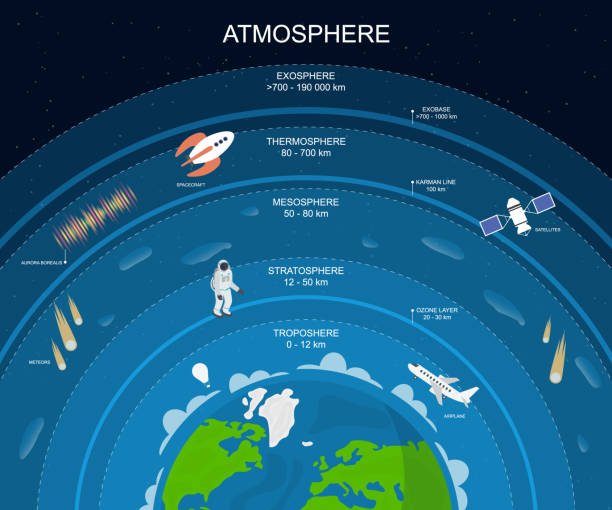JOIN OUR WHATSAPP GROUP. CLICK HERE
7 Reasons Why long-distance Aircraft Choose to Fly in the Lower Part of the Stratosphere
7 Reasons Why long-distance Aircraft Choose to Fly in the Lower Part of the Stratosphere Do you know why long-distance planes opt to soar over the lower stratosphere? On this page, we’ll go over 7 typical justifications for why long-distance airplanes opt to fly in the lower stratosphere.
What is a Stratosphere
First of all, do you know what a stratosphere is? The stratosphere is the second layer of the Earth’s atmosphere, located above the troposphere (the layer closest to the Earth’s surface) and below the mesosphere. It extends from an altitude of about 10 km (6.2 miles) to 50 km (31 miles) above the Earth’s surface.
Video Lesson: The Layers Of Atmosphere
The stratosphere is characterized by its relatively stable and dry air, as well as its lack of weather patterns and storms. This layer of the atmosphere also contains the ozone layer, which protects the Earth from harmful ultraviolet (UV) radiation from the sun.
The air temperature in the stratosphere increases with altitude, due to the absorption of UV radiation by ozone. The wind in the stratosphere is also relatively stable, with the exception of the jet streams, which are high-speed winds that flow from west to east.
The stratosphere is also home to a number of important atmospheric processes, including the formation of ozone, the formation of polar stratospheric clouds, and the distribution of atmospheric trace gases.
In addition to being a vital layer for the Earth’s atmosphere and climate, the stratosphere is also used for commercial and military aviation. Long-distance aircraft often fly in the lower part of the stratosphere, because it offers a more stable flight and more efficient fuel consumption.
Overall, the stratosphere is an important layer of the Earth’s atmosphere that plays a vital role in protecting the planet from harmful UV radiation and regulating the Earth’s climate.
7 Reasons Why long-distance Aircraft Choose to Fly in the Lower Part of the Stratosphere
There are several reasons why long-distance aircraft choose to fly in the lower part of the stratosphere:

- Altitude: The lower part of the stratosphere is located at an altitude of around 20,000 to 30,000 feet. This altitude is high enough to avoid most of the turbulence and storms that occur in the troposphere (the layer of the atmosphere closest to the earth), but it is still low enough for the aircraft to have a relatively stable flight.
- Air density: The air density in the lower part of the stratosphere is also relatively low, which means that the aircraft can fly more efficiently and use less fuel.
- Weather: The lower part of the stratosphere is generally free of the weather patterns and storms that occur in the troposphere. This means that aircraft flying in this layer of the atmosphere can avoid disruptions caused by bad weather and can fly more smoothly.
- Jet Streams: The lower part of the stratosphere is also home to the jet streams, which are high-speed winds that can help aircraft fly faster and more efficiently. These winds can help aircraft reach their destinations faster, reducing travel time and fuel costs.
- Air Traffic: The lower part of the stratosphere is also less congested than the airspace at lower altitudes, which means that aircraft can fly more freely and avoid delays caused by air traffic.
- Cost: Because of the benefits mentioned above, flying in the lower part of the stratosphere can be more cost-effective for long-distance aircraft. They can save fuel, avoid bad weather, and reach their destinations faster, which can lead to significant cost savings.
- Environmental Impact: Flying in the lower part of the stratosphere also has a lower environmental impact than flying at higher altitudes. The lower air density in this layer of the atmosphere means that aircraft can emit less carbon dioxide and other pollutants.
In conclusion, long-distance aircraft choose to fly in the lower part of the stratosphere because it offers a more stable flight, more efficient fuel consumption, avoidance of weather patterns, faster travel times, less congested airspace, cost savings, and a lower environmental impact.
How to Pass Agricultural Sciences Grade 11 with distinctions
One of the most significant accomplishments in your academic career is passing matric. It provides access to a wide range of post secondary options and employment possibilities. Use our best study advice to complete your matriculation, and you’ll succeed with flying colors.
- Attend class
- Ask questions
- Make notes
- Study
- Practise
- Study groups
- Extra class
- Motivation
- Complete assessments
- Prepare for the Exams in due time
Download Past Exam Papers & Memo per Province
- Department of Basic Education Grade 9 Exams
- Eastern Cape Papers and Memorandum
- Free State Papers and Memorandum
- Gauteng Papers and Memorandum
- KwaZulu-Natal Papers and Memorandum
- Limpopo Papers and Memorandum
- Mpumalanga Papers and Memorandum
- Northern Cape Papers and Memorandum
- North West Papers and Memorandum
Western Cape Papers and Memorandum
JOIN OUR TELEGRAM CHANNEL. CLICK HERE

Be the first to comment